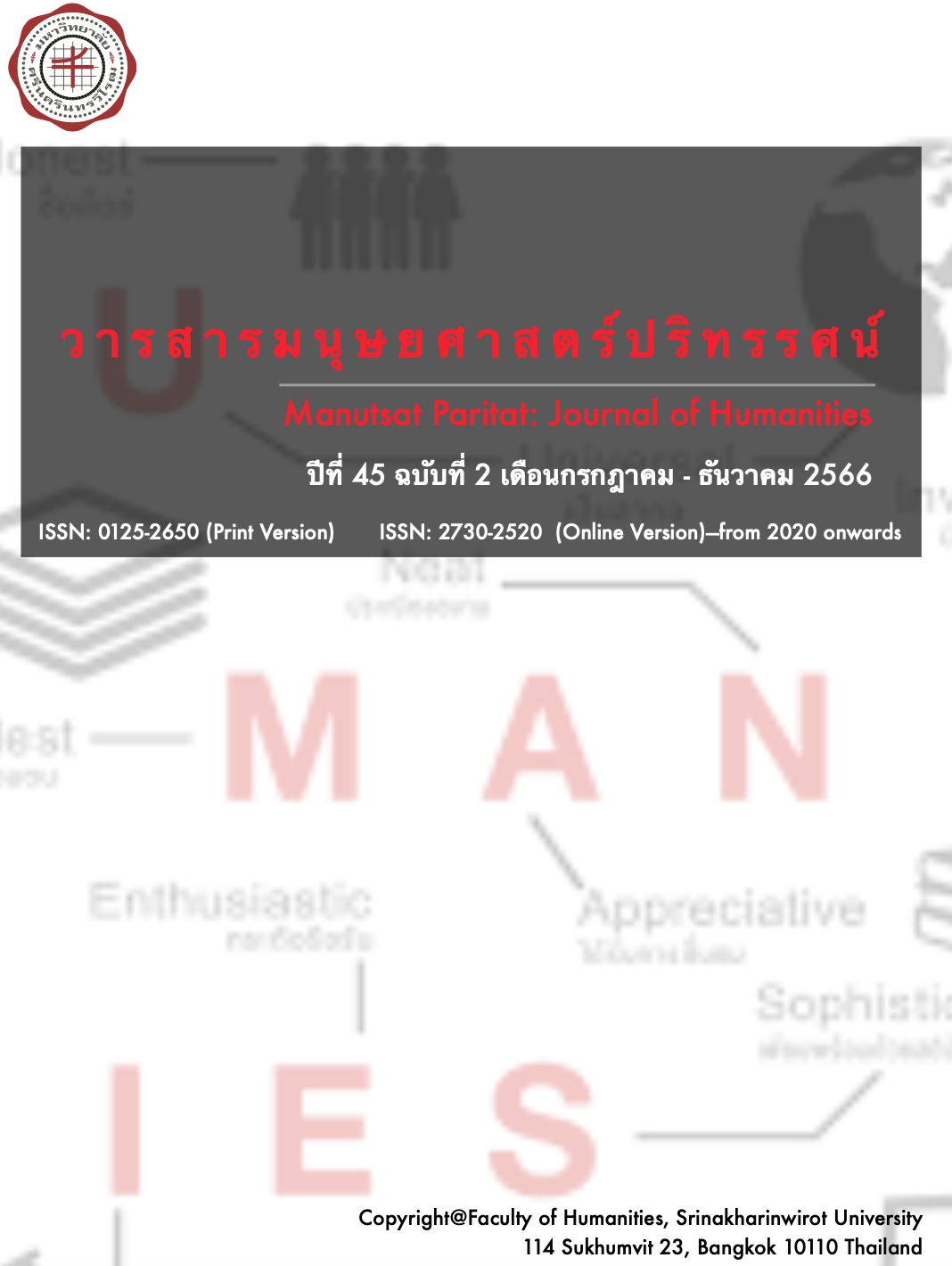A Review of Studies in Heart or Jai Metaphor in Thai Language
Main Article Content
Abstract
This paper primarily aims to gather and review the conceptual metaphor studies of the term “heart” or “jai” (ใจ) in Thai. Also, some other semantic studies of the word “heart” or “jai” in Thai are included in this review article. Although the metaphor research of “jai” or “ใจ” in Thai is not much found, the results of those heart metaphor studies yield significant results of how Thai natives view and understand the word “heart” or “jai.” The metaphors of the word “jai” can be categorized into four major groups: (1) HEART AS PERSON/HUMAN; (2) HEART AS OBJECT; (3) HEART AS SPACE; (4) HEART AS CONTAINER. To conclude, this organ term “jai” attached to an abundant number of phrases spoken daily plays an important role in communication in Thai, which reflects the native speakers’ perspectives on the heart.
Article Details

This work is licensed under a Creative Commons Attribution-NonCommercial-NoDerivatives 4.0 International License.
Any unauthorized copying, publication, reproduction or distribution of copyrighted works appeared in Manutsat Paritat: Journal of Humanities is an infringement of the copyright owners’ rights. To authorize the copying, publication, reproduction or distribution of copyrighted works to be appeared in other printed materials or any online media, please write to MPJHthaijo@gmail.com for permission.
References
Croft, W. A. (2001). Functional approaches to grammar. In N. J. Smelser & P. B. Baltes (Eds.), International
encyclopedia of the social and behavioral sciences (pp. 6323–6330). Elsevier Sciences. https://doi.org/10.1016/B0-08-043076-7/02946-6
Daraselia, N. (2017). Metaphorical conceptualization of face in the Georgian language and culture [Abstract}.
Book of abstracts – Metaphor festival 2017 (p.13). Retrieved July 27, 2023, from
Fillmore, C. (1982). Frame semantics. In the linguistics society of Korea (Ed.), Linguistics in the morning calm: Selected papers from SICOL-1981 (pp. 111-137). Hanshin Pub. Co. http://brenocon.com/Fillmore%201982_2up.pdf
Iwasaki, S., & Ingkaphirom, P. (2005). A reference grammar of Thai. Cambridge University Press.
Johnson, M. (2007). The meaning of the body: Aesthetics of human understanding. University of Chicago
Press.
Kövecses, Z. (2000). Metaphor and emotion: Language, culture and body in human feeling. Cambridge
University Press.
Kövecses, Z. (2002). Metaphor: A practical introduction. Oxford University Press.
Lakoff, G. (1987). Women, fire and dangerous things: What categories reveal about the mind. University of
Chicago Press.
Lakoff, G., & Johnson M. (1980). Metaphors we live by. Chicago University Press.
Langacker, R. W. (1987). Foundations of cognitive grammar: Theoretical prerequisites (Vol. 1). Stanford
University Press.
Langacker, R. W. (1991). Foundations of Cognitive Grammar: Descriptive application (Vol. 2). Stanford
University Press.
Lertkultanon, S. (2012). “cai”: traits, moods, feelings. Thammasart Journal, 31(2), 87-94.
http://tujournals.tu.ac.th/thammasatjournal/detailart.aspx?ArticleID=59
Matisoff, J. A. (1986). Hearts and minds in South-East Asian languages and English: An essay in the comparative
lexical semantics of psycho-collocations. Cahiers de Linguistique Asie Orientale, 15(1), 5-57.
https://doi.org/10.3406/clao.1986.1191
Park, K. E. (2015). Conceptualization of /chai/ in Thai in comparison with Korean counterpart. Journal of
Liberal Arts, 15(2), 199-212. https://so03.tcithaijo.org/index.php/liberalarts/article/download/46207/38231/106947
Phonthad, P., & Intajamornrak, C. (2020). Metaphors of body parts words in Burmese. Journal of Humanities
and Social Sciences, 15(2), 27–47. https://so03.tcithaijo.org/index.php/eJHUSO/article/view/248326
Rungchaeng, S. (2005). Conceptual metaphors using /cay/ (heart/mind) in Thai [Unpublished master’s thesis].
Thammasat University.
Saralamba, C. (2008, May 30). Heart metaphors in Thai language [Abstract}. RaAM.
https://raam.org.uk/archive/raam7/Papers.pdf
Stefanowitsch, A. (2006). Words and their metaphors: A corpus-based approach. In A. Stefanowitsch
and S.T. Gries (Eds.), Corpus-based approaches to metaphor and metonymy (pp. 36-62). Mouton de Gruyter.
Talmy, L. (2000). Toward a cognitive semantics: Concept structuring systems (Vol. 1). MIT Press.
Talmy, L. (2006). Cognitive linguistics. In K. Brown, Encyclopedia of language & linguistics (2nd ed., pp.
-546). Elsevier Sciences. https://doi.org/10.1016/B0-08-044854-2/00351-5.
Ukosakul, M. (1999). Conceptual metaphors motivating the use of Thai ‘face’ [Unpublished master’s thesis].
Payap University.
Yao, S. (2018). Conceptual system of “HEART” in Thai in comparison to Chinese: A cognitive linguistics
approach [Unpublished master’s thesis]. Thammasat University.
Yu, N. (2003). Metaphor, body, and culture: The Chinese understanding of gallbladder and courage, Metaphor
and Symbol, 18(1), 13-31. http://dx.doi.org/10.1207/S15327868MS1801_2
Yu, N. (2007). Heart and cognition in ancient Chinese philosophy. Journal of Cognition and Culture, 7, 27-47.
http://dx.doi.org/10.1163/156853707X171801
Yu, N. (2009). The Chinese HEART in a cognitive perspective: Culture, body, and language. Mouton de Gruyter.


